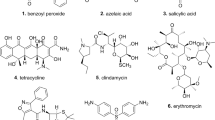Abstract
The antibacterial activity of the topical quinolone OPC-7251 against bacteria commonly found in acne vulgaris was tested in vitro by an agar dilution method. The MIC50 was 0.25 mg/l forPropionibacterium acnes, 0.125 mg/l forPropionibacterium granulosum, 0.03 mg/l forStaphylococcus aureus and 0.06 mg/l for coagulase-negative staphylococci. Compared with seven other antibiotics tested (ciprofloxacin, penicillin, erythromycin, tetracycline, clindamycin, fusidic acid and gentamicin), OPC-7251 had potent activity against both propionibacteria and staphylococci and the lowest incidence of resistant strains.
Similar content being viewed by others
References
Leeming JP, Holland KT, Cunliffe WJ The microbial colonization of inflamed acne vulgaris lesions. British Journal of Dermatology 1988, 118: 203–208.
Cunliffe WJ Microbiology of acne. In: Cunliffe WJ (ed): Acne. Martin Dunitz, London, 1989, p. 178–210.
Gollnick H, Zouboulis CC, Akamatsu H, Kurokawa I, Schulte A Pathogenesis and pathogenesis related treatment of acne. Journal of Dermatology 1991, 18: 489–499.
Eady EA, Cove JH, Holland KT, Cunliffe WJ Erythromycin resistant propionibacteria in antibiotic treated acne patients: association with therapeutic failure. British Journal of Dermatology 1989, 121: 51–57.
Kawabata S, Ohguro K, Mukai F, Ohmori K, Miyamoto H, Tamaoka H Bacteriological evaluation of OPC-7251, a new pyridone carboxylic acid antimicrobial agent. 1: In vitro antibacterial activity. Japanese Journal of Chemotherapy 1989, 37: 1160–1178.
Kawabata S, Masada H, Wakebe H, Ohmori K, Tamaoka H Bacteriological evaluation of OPG-7251, a new pyridone carboxylic acid antimicrobial agent. 2: Therapeutic effect of OPC-7251 cream on experimental infection model in mice. Japanese Journal of Chemotherapy 1989, 37: 1179–1183.
Kurokawa I, Akamatsu H, Nishijima S, Asada Y, Kawabata S Clinical and bacteriological evaluation of OPC-7251 in patients with acne: a double-blind group comparison study versus cream base. Journal of the American Academy of Dermatology 1991, 25: 674–681.
Lee WL, Shalita AR, Suntharalingam K, Fikrig SM Neutrophil chemotaxis byPropionibacterium acnes lipase and its inhibition. Infection and Immunity 1982, 35: 71–78.
Eady EA, Holland KT, Cunliffe WJ The use of antibiotics in acne therapy: oral or topical administration? Journal of Antimicrobial Chemotherapy 1982, 10: 89–115.
Eady EA, Ross JI, Cove JH, Holland KT, Cunliffe WJ The effects of oral erythromycin therapy for acne on the development of resistance in cutaneous staphylococci and propionibacteria. In: Marks R, Plewig G (ed): Acne and related disorders. Martin Dunitz, London, 1989, p. 265–270.
Author information
Authors and Affiliations
Rights and permissions
About this article
Cite this article
Vogt, K., Hermann, J., Blume, U. et al. Comparative activity of the topical quinolone OPC-7251 against bacteria associated with acne vulgaris. Eur. J. Clin. Microbiol. Infect. Dis. 11, 943–945 (1992). https://doi.org/10.1007/BF01962381
Issue Date:
DOI: https://doi.org/10.1007/BF01962381




